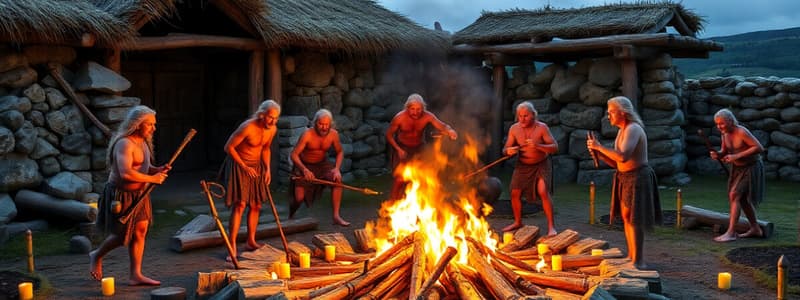Podcast
Questions and Answers
What was Odin's promise to Harald in exchange for victory?
What was Odin's promise to Harald in exchange for victory?
- To provide wealth and riches
- To grant eternal life
- To dedicate all slain warriors to him (correct)
- To protect his kingdom from all enemies
Which of the following items were commonly included in offerings to Odin?
Which of the following items were commonly included in offerings to Odin?
- Weapons like swords and shields (correct)
- Food and drink
- Jewelry and precious stones
- Clothing and textiles
What does the story of the grey wolf imply about Odin?
What does the story of the grey wolf imply about Odin?
- He had no regard for his followers
- He was invincible and could never be defeated
- He could be robbed of victory (correct)
- He was indifferent to human sacrifices
How were sacrifices to Odin sometimes performed?
How were sacrifices to Odin sometimes performed?
What was the significance of Odin's spear, Gungnir?
What was the significance of Odin's spear, Gungnir?
What method of sacrifice was associated with the Tollund man?
What method of sacrifice was associated with the Tollund man?
What could be inferred about warriors dedicated to Odin?
What could be inferred about warriors dedicated to Odin?
Which of the following was found in the bogs as evidence of sacrifices to Odin?
Which of the following was found in the bogs as evidence of sacrifices to Odin?
Flashcards
Odin's Promises and Invincibility
Odin's Promises and Invincibility
Odin, a major Norse god, was associated with war, death, wisdom, and the hunt. He was known to make promises to his followers, but often broke them. This shows that even gods were not invincible and could be defeated.
Battle Sacrifices to Odin
Battle Sacrifices to Odin
Many kings and warriors offered sacrifices to Odin, the god of the dead, in the form of slain enemies or valuable possessions. These sacrifices were often accompanied by rituals like bending or breaking weapons, symbolizing dedication to Odin.
Ritual Hanging in Norse Mythology
Ritual Hanging in Norse Mythology
Odin was associated with hanging sacrifices, and many stories tell of captives or even kings sacrificing their own children by hanging them from trees. This is further supported by the discovery of bodies with ropes around their necks in bogs.
Odin's Spear: Gungnir
Odin's Spear: Gungnir
Signup and view all the flashcards
Warriors of Odin: Fighting Without Armor
Warriors of Odin: Fighting Without Armor
Signup and view all the flashcards
Lurs: Bronze Wind Instruments
Lurs: Bronze Wind Instruments
Signup and view all the flashcards
The Tollund Man: A Sacrificial Victim
The Tollund Man: A Sacrificial Victim
Signup and view all the flashcards
Blindfolded Sacrifice in the Bog
Blindfolded Sacrifice in the Bog
Signup and view all the flashcards
Study Notes
Norse Mythology: Sacrificial Practices
- Odin's Promises: Odin, the Norse god, made promises of victory to followers, but these promises weren't always kept. This tied into the concept of inevitable defeat.
- Battle Sacrifices: Stories exist of kings making deals with Odin, giving him those killed in battle as sacrifices. Such sacrifices were often reported and confirmed by historical accounts.
- Archaeological Evidence: Excavations of peat bogs in Denmark and Sweden reveal offerings from defeated armies. These included weapons, armor, and human remains.
- Ritual Hanging: Sacrificial victims, including humans, were sometimes found with ropes around their necks, indicating strangulation.
- Evidence from Foreign Writers: Historical accounts from Tacitus and others correlate with preserved findings of sacrifices.
- Offerings by Germanic Tribes: Tacitus mentions two Germanic tribes who vowed to sacrifice all war spoils to their gods.
- Sacrificial Objects: Swords, shields, mail, spears, bows and arrows, and ships (such as the Hjortspring boat, filled with warriors' equipment), along with valuables were included in the sacrifices.
- Preparation of Sacrificial Items: Weapons were sometimes damaged or burned before being left as offerings.
Odin's Cult and Sacrifice
- Ritual Hanging of Victims: War captives and sometimes even kings' sons were victims of ritual killings, hung from trees in sacred groves.
- Specific Sacrifice of King Vikar: This example details a specific case of a king sacrificing himself according to the will of the Gods. He was placed on a stump with calf entrails substituted for rope.
- Odin's Symbolism:
- The Spear: The spear had both practical and symbolic value, representing Odin, victory, and war.
- The Eagle: An Eagle, Odin's bird, was present in many representations of sacrifice.
- The twisted Knot: This symbol was linked with Odin, and often observed in the stone carvings.
Additional Insights
- Sacrifice of Unborn Children: Historical accounts also discussed sacrifices of unborn children, illustrating the extreme measures taken in some rituals.
- Sacrificing Sons: Kings were known to offer the lives of their sons as sacrifices to gain longer lifespans or favors.
- Variety of Sacrificial Victims: Victims could include both prisoners of war and people chosen from the king's family.
- The Spear of Odin: Odin's spear, Gungnir, was a powerful symbol associated with gaining victory through battle.
- Viking Age Spears: Spears found in Viking Age sites often show intricate decoration, supporting their symbolic function within the culture.
- Instruments: Bronze wind instruments (lurs) discovered in bogs had a religious or ceremonial use.
- Blindfolded Victims Evidence of blindfolded, strangled victims has been found in the bogs, suggesting a specific ritual practice.
Studying That Suits You
Use AI to generate personalized quizzes and flashcards to suit your learning preferences.



